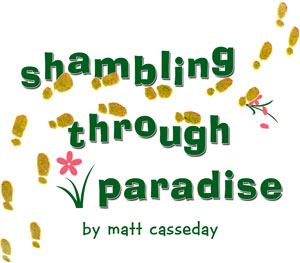The Unsellable Curvito
 My first car in Costa Rica was a ‘77 Jeep Curvito. Like most of the seven cars I have bought since, it was a teenager. It had a removable soft top, no radio and was a dull purplish gray—the color of a bad bruise. It also had an extended back end. In my years of owning it, I never saw another Jeep anywhere on the road that had an extended back end. The body of the Jeep had been manufactured in Costa Rica, in the mid-70s—there was a metal stamp on the inner hood that said so. I had never heard of a Curvito, didn’t know what the word ‘Curvito’ meant. With time I decided it meant either, “Jeep that makes mechanic shake his head in dismay’’ or “Jeep that’s replacement parts are nonexistent”.
My first car in Costa Rica was a ‘77 Jeep Curvito. Like most of the seven cars I have bought since, it was a teenager. It had a removable soft top, no radio and was a dull purplish gray—the color of a bad bruise. It also had an extended back end. In my years of owning it, I never saw another Jeep anywhere on the road that had an extended back end. The body of the Jeep had been manufactured in Costa Rica, in the mid-70s—there was a metal stamp on the inner hood that said so. I had never heard of a Curvito, didn’t know what the word ‘Curvito’ meant. With time I decided it meant either, “Jeep that makes mechanic shake his head in dismay’’ or “Jeep that’s replacement parts are nonexistent”.
I had arrived in CR as half of a couple, but in 2 short years we had become a family of 4 and it was time to go back north to make enough money to return. I took on the task of selling the Curvito. It was the early 1990s in Costa Rica—no cell phones, no internet. We lived about a 20 minute drive from the nearest pay phone. A retired alcoholic American I knew had a house with a landline phone in San Isidro del General. He loaned me his phone number so I could place an ad in La Nacion. I spent the weekend at his house, fielding inquiries and trying not to drink too much. But I had a half dozen calls that expressed interest, including a wealthy Texan who assured me that he was ready to buy it sight unseen, and that, aw shucks, if he didn’t buy it, he had an off street parking area where I could store it until I did find a buyer.
Monday morning I headed out at 4am toward San Jose. I dressed as I always did for San Jose—jeans, Hawaiian shirt, light windbreaker/rain jacket. As I reached the top of Cerro del Muerte an hour later, I wondered what in the hell I had been thinking an hour earlier. Lightly dressed, in a rag top car with no heat, I shivered in agony. Of course there was a reason they named this 10,000-foot height the “Mountain of Death”. There was no place along the road open at the early hour where I could stop and warm myself. I shook and gripped the wheel as I drove, screaming for the sun to break over the mountain to my east. “Ex-Local Man Freezes to Death in Tropics’’—It would be the head-scratching headline in the papers back home. Maybe even a Darwin award candidate. When the sun finally peeked over the ridge, I concentrated on feeling its warm rays reaching me, saving my life.
By the time I reached Cartago at the base of the mountain the temperatures were in the 50s, which felt downright balmy. I made it to San Jose, to the offices of the Texan. He greeted me excitedly. When he came down to look at my Curvito, his expression changed—my car was all hat and no cattle for him, I could tell instantly. Maybe it was the ugly color or the frayed rag top. Maybe it was the extended back end. Maybe it was the strong scent of gasoline that emanated from it. He hemmed and hawed and said he would think it over. And dadgum it if he didn’t also forget about his promise to let me store it there.
Over the next 2 days I paid to store my car in a 24 hour parking lot near La Sabana Park. All of my other prospective buyers reacted similarly to the Texan once they got a look at it. Apparently all Jeeps are not considered equals, especially if they are called Curvitos. Two mornings later, I decided to drive back over the Cerro del Muerte at an hour that minimized the risk of death by exposure.
It wasn’t until a month later that I actually made it back over the mountain. The Curvito broke down in Escazu before I could get started. A Tico mechanic towed me to his house, invited me to stay with his family, hosted my family later in the month, invited me to many beers, and fixed my car—once we found the hard-to-get parts. The Curvito remained ours in the following years until it expired of old age and abuse in its mid-20s.
